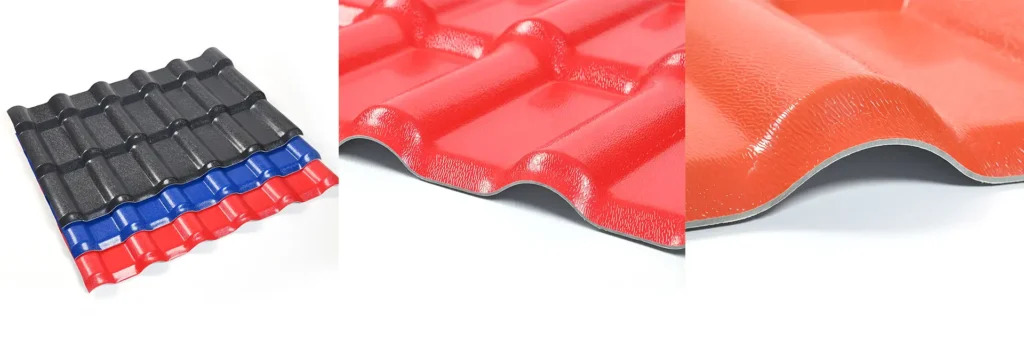Synthetic resin roof tiles, as commonly used roofing and wall covering materials in construction, have their durability closely linked to maintenance. Doing a good job in maintenance can effectively extend their service life and bring into play their excellent properties such as heat insulation, noise reduction, rust resistance and corrosion resistance.

Key Factors Affecting the Service Life of Synthetic Resin Roof Tiles
Climatic conditions are an important factor affecting synthetic resin roof tiles. They are exposed to various environmental factors such as ultraviolet rays, rainfall, gusts and temperature fluctuations for a long time. Although the ASA layer (a type of acrylic/resin) on the top of UPVC roof panels can resist ultraviolet rays and keep the color bright for 8 to 10 years, if maintenance is not timely, continuous exposure will lead to a decline in the performance of the tiles. In high-temperature areas, long-term exposure to intense sunlight may accelerate the aging of resin materials; in rainy areas, long-term scouring by rainwater may damage the sealing performance at the joints of the tiles.
At the same time, organic growth can also cause damage to them. Microorganisms such as mold, algae and moss are easy to breed in humid environments. If left unchecked, they may fade or damage the tiles. Therefore, it is crucial to regularly check for signs of organic matter spread. The growth of these microorganisms will secrete acidic substances, which will gradually erode the surface of the tiles and affect their appearance and structural integrity.
In addition, human factors cannot be ignored. For example, when carrying out installation, maintenance and other operations on the roof, accidental stepping on the tiles may cause them to crack or deform; randomly piling heavy objects on the roof will also bring additional pressure to the tiles, affecting their service life.
Core Maintenance Methods for Synthetic Resin Roof Tiles
Daily cleaning and inspection are the core of maintenance. Cleaning can remove surface dirt, debris and organic matter, and UPVC roof panels do not make harsh noises like steel plates when being cleaned, but cleaning needs to be thorough and comprehensive. When cleaning, it is recommended to use neutral detergents and avoid using corrosive detergents such as strong acids and alkalis, so as not to damage the ASA layer on the surface of the tiles. You can dip a soft brush or sponge in the detergent and wipe gently, then rinse with clean water. For some stubborn stains, you can soak them for a period of time before cleaning.
Inspection should timely detect problems such as tile cracks and looseness. Relevant products have passed CNAS and UL testing certifications to ensure stable quality. The inspection frequency can be determined according to climatic conditions and usage environment. Generally, it is recommended to inspect at least once a quarter. After severe weather such as heavy rain and typhoons, inspections should also be carried out in a timely manner.
In addition, adding a shielding layer or treatment agent can enhance the toughness of the tiles. ASA itself has a certain protective effect, and additional treatment agents can further improve its ability to resist ultraviolet rays and other outdoor factors. When choosing a treatment agent, select products that match the material of the synthetic resin roof tiles and apply them correctly according to the product instructions.
The drainage system of the roof should also be maintained regularly to ensure that rainwater can be discharged smoothly. If the drainage is not smooth, rainwater will accumulate on the roof, which will increase the burden on the tiles and may seep into the interior of the tiles, causing damage. It is necessary to timely clean up the debris in the gutters and downpipes to ensure that the drainage channels are unobstructed.
Key Points for Repair and Replacement of Synthetic Resin Roof Tiles
Timely detection of damage is the key to repair and replacement. Pay attention to signs such as cracked tiles and possible water leakage. For example, glass fiber reinforced UPVC roof panels have a layered structure with glass fiber mesh embedded, which has high tensile strength and impact resistance, but damage should still be paid attention to. When slight cracks are found in the tiles, special resin glue can be used for repair; if the cracks are large or the tiles are broken, they need to be replaced in time.
In terms of maintenance methods, you need to choose DIY or expert repair according to the degree of damage and your own technical level. Small problems can be solved with basic equipment, while more difficult problems require professionals. Jieli will provide solutions to customers’ questions about maintenance through comprehensive inspections. When replacing tiles, choose products with the same specifications and colors as the original tiles to ensure the overall beauty and performance of the roof. When installing new tiles, ensure that they are fixed firmly to avoid loosening.
In addition, when synthetic resin roof tiles have been used for a certain number of years and have large-scale aging, deformation and other conditions, even if there is no obvious damage, it is recommended to replace them as a whole to ensure the safe use of the roof.
In conclusion, mastering the knowledge of maintenance, repair and replacement of synthetic resin roof tiles can effectively improve their durability and ensure the long-term stable operation of the roof system. In practice, scientific and reasonable measures should be taken in combination with specific conditions to maximize the effectiveness of synthetic resin roof tiles.



